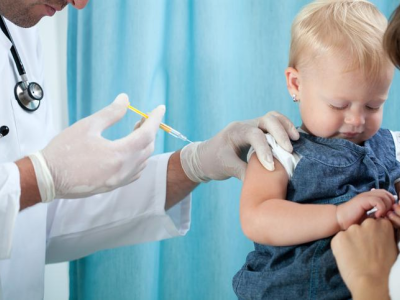CDC: 19 flu-related deaths in children reported last week
Some measures of influenza activity in the United States decreased last week, but 19 flu-related deaths in children were reported, far higher than any previous week of the season, the Centers for Disease Control and Prevention (CDC) said in today's weekly update.
The 19 deaths raised this season's total to 45, the CDC reported. In addition, the share of all deaths related to flu and pneumonia jumped to 8.5%, well above the previous week's 7.0%, which is also the CDC's epidemic threshold at this point in the season.
Among markers that decreased was the proportion of clinic visits prompted by flu-like illness, which was 4.4% last week, compared with 5.6% the week before. Also, 20.2% of 26,204 respiratory samples tested positive for flu, versus 24.7% of 30,469 samples a week earlier.
In addition, the count of states reporting high flu activity last week was 24, down from 26 states a week earlier. Puerto Rico also reported high activity both weeks.
Jurisdictions that reported geographically widespread flu last week included 46 states and Guam, which was the same as the week before.
The 19 reported deaths in children occurred over the past 4 weeks, the CDC said. Eight of the deaths were associated with H3N2 viruses, 1 with an influenza B virus, 9 with type A viruses that were not subtyped, and 1 with a virus that was not typed.
Influenza A viruses continued to vastly outnumber influenza B, accounting for 95.6% of isolates analyzed, and nearly all of them were H3N2 viruses. Antigenic characterization showed that 65.0% of the tested H3N2 isolates so far this season were not well matched with the H3N2 component in the vaccine, slightly lower than the 68.4% mismatch cited a week earlier.
The cumulative rate of flu-related hospitalizations reached 29.9 per 100,000 population overall last week, with a rate of 143.3 per 100,000 in people 65 and older, the CDC reported.
Jan 16 FluView update
Jan 9 FluView update
Study: Flu VE against hospitalization in 2012-13 in Europe highest for H3N2
Vaccine effectiveness against hospitalization during the 2012-13 influenza season within the population targeted for flu vaccination in Europe varied by viral subtype and patient age-group, with the highest effectiveness—at 62%—against the H3N2 strain and the lowest against the 2009 H1N1 strain, found a case-control, test-negative study published yesterday in Eurosurveillance.
The study population comprised 1,972 adult patients admitted for influenza-like illness (ILI) during the 2012-13 flu season to 18 hospitals in France, Italy, Lithuania, and Spain. The patients were within the target population for flu vaccination in Europe, meaning those at risk for exposure to the flu virus and those at risk for severe disease.
Subjects testing positive for influenza were considered cases, with subtyping of the infecting virus carried out, and those testing negative were controls; 58 patients were positive for H3N2 influenza, 116 for 2009 H1N1, and 232 for influenza B.
Vaccine effectiveness (VE) against hospitalization, adjusted for several factors, was calculated as 61.8% (95% confidence interval [CI], 26.5% to 80.0%) in patients with type H3N2, 43.1% (95% CI, 21.2% to 58.9%) in those with type B, and 21.3% (95% CI, –25.2% to 50.6%) in those with 2009 H1N1, with an even lower VE for all three strains in the elderly. The VE for 2009 H1N1 was not statistically significant.
A similar study, published in the Feb 10, 2014, issue of Eurosurveillance, assessed the same vaccine but in medically attended ILI patients in the target population and found quite different results: adjusted VE was highest for 2009 H1N1—50.4%—and lowest for H3N2, at 42.2%, with type B falling between, at 49.3%, and VE for all three strains reaching statistical significance.
Jan 15 Eurosurveillance study
Feb 10, 2014, Eurosurveillance study
Chinese officials report 16 new H7N9 cases
Officials in China have reported a new H7N9 avian flu case in Jiangxi province and 15 new cases in Fujian province—the first reported this year outside of Guangdong province—according to translated health ministry statements.
The patient in Jiangxi is a 34-year-old man in Ganzhou city, according to a provincial health commission statement posted today on FluTrackers, an infectious disease message board. He is hospitalized in critical condition.
In Fujian province, 2 of the 15 H7N9 cases have been fatal, and all have presumably been confirmed since the first of the year, according to a provincial health department notice posted today on the blog Avian Flu Diary. Cases are in Fuzhou, the provincial capital, as well as the cities of Xiamen, Putian, Quanzhou, and Zhangzhou. The deaths occurred in Xiamen and Putian.
All previous cases this year in China—nine of them—have been in Guangdong province. The new cases bring the global total of H7N9 cases to 510, according to a case list compiled by FluTrackers.
Jan 16 FluTrackers post
Jan 16 Avian Flu Diary post
FluTrackers H7N9 case list
Egypt confirms another H5N1 death
Health officials have confirmed Egypt's third death this year from H5N1 avian flu, Reuters reported today.
The victim, a 43-year-old woman, lived in a village in Asyut governorate near the center of the country along the Nile. She had direct contact with infected birds, a health ministry official said.
The new case brings Egypt's H5N1 total this year at least to 12, including the 3 deaths, according to media and health ministry reports. The most recent previous death, in a 65-year-old woman in the city of Asyut, was reported 2 days ago.
The World Health Organization (WHO) said last week that the month that ended on Jan 6 was Egypt's busiest ever for H5N1 cases.
Jan 16 Reuters report
Jan 12 CIDRAP News story on recent WHO update












